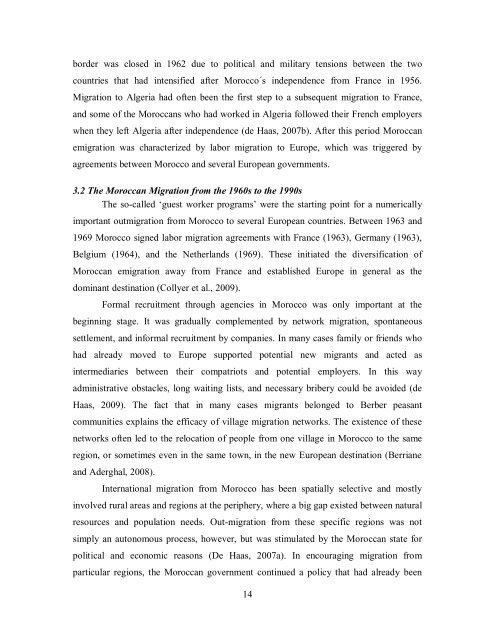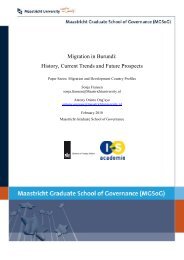Migration in Morocco: History, Current Trends and Future ... - MGSoG
Migration in Morocco: History, Current Trends and Future ... - MGSoG
Migration in Morocco: History, Current Trends and Future ... - MGSoG
Create successful ePaper yourself
Turn your PDF publications into a flip-book with our unique Google optimized e-Paper software.
order was closed <strong>in</strong> 1962 due to political <strong>and</strong> military tensions between the two<br />
countries that had <strong>in</strong>tensified after <strong>Morocco</strong>´s <strong>in</strong>dependence from France <strong>in</strong> 1956.<br />
<strong>Migration</strong> to Algeria had often been the first step to a subsequent migration to France,<br />
<strong>and</strong> some of the Moroccans who had worked <strong>in</strong> Algeria followed their French employers<br />
when they left Algeria after <strong>in</strong>dependence (de Haas, 2007b). After this period Moroccan<br />
emigration was characterized by labor migration to Europe, which was triggered by<br />
agreements between <strong>Morocco</strong> <strong>and</strong> several European governments.<br />
3.2 The Moroccan <strong>Migration</strong> from the 1960s to the 1990s<br />
The so-called ‘guest worker programs’ were the start<strong>in</strong>g po<strong>in</strong>t for a numerically<br />
important outmigration from <strong>Morocco</strong> to several European countries. Between 1963 <strong>and</strong><br />
1969 <strong>Morocco</strong> signed labor migration agreements with France (1963), Germany (1963),<br />
Belgium (1964), <strong>and</strong> the Netherl<strong>and</strong>s (1969). These <strong>in</strong>itiated the diversification of<br />
Moroccan emigration away from France <strong>and</strong> established Europe <strong>in</strong> general as the<br />
dom<strong>in</strong>ant dest<strong>in</strong>ation (Collyer et al., 2009).<br />
Formal recruitment through agencies <strong>in</strong> <strong>Morocco</strong> was only important at the<br />
beg<strong>in</strong>n<strong>in</strong>g stage. It was gradually complemented by network migration, spontaneous<br />
settlement, <strong>and</strong> <strong>in</strong>formal recruitment by companies. In many cases family or friends who<br />
had already moved to Europe supported potential new migrants <strong>and</strong> acted as<br />
<strong>in</strong>termediaries between their compatriots <strong>and</strong> potential employers. In this way<br />
adm<strong>in</strong>istrative obstacles, long wait<strong>in</strong>g lists, <strong>and</strong> necessary bribery could be avoided (de<br />
Haas, 2009). The fact that <strong>in</strong> many cases migrants belonged to Berber peasant<br />
communities expla<strong>in</strong>s the efficacy of village migration networks. The existence of these<br />
networks often led to the relocation of people from one village <strong>in</strong> <strong>Morocco</strong> to the same<br />
region, or sometimes even <strong>in</strong> the same town, <strong>in</strong> the new European dest<strong>in</strong>ation (Berriane<br />
<strong>and</strong> Aderghal, 2008).<br />
International migration from <strong>Morocco</strong> has been spatially selective <strong>and</strong> mostly<br />
<strong>in</strong>volved rural areas <strong>and</strong> regions at the periphery, where a big gap existed between natural<br />
resources <strong>and</strong> population needs. Out-migration from these specific regions was not<br />
simply an autonomous process, however, but was stimulated by the Moroccan state for<br />
political <strong>and</strong> economic reasons (De Haas, 2007a). In encourag<strong>in</strong>g migration from<br />
particular regions, the Moroccan government cont<strong>in</strong>ued a policy that had already been<br />
14



